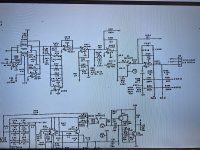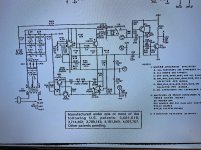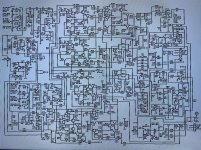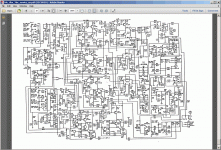There is/was a shop in Idaho that was doing upgrades to the DBX 3BX series one dynamic range expander. One of the things they did was swap out ICs for a much better OPA2134. It was a drop in replacement, no mods to the surrounding circuit needed. Other than that I can’t get any other information. This is what is in the unit:
10 - LF351N
8 - LF353N
10 - RC4558P
1 - LM301N
3 - unknown, the markings have been removed.
My best guess is the RC4558P. Could it be possible to replace the LF351N and LF353N with the OPA134 and OPA2134? I really wish I could get more info on this.
Is link a schematic, but the only one I can find isnt the best quality and needs to be zoomed in on. The images I post get fairly degraded.
Thank you,
Dan
10 - LF351N
8 - LF353N
10 - RC4558P
1 - LM301N
3 - unknown, the markings have been removed.
My best guess is the RC4558P. Could it be possible to replace the LF351N and LF353N with the OPA134 and OPA2134? I really wish I could get more info on this.
Is link a schematic, but the only one I can find isnt the best quality and needs to be zoomed in on. The images I post get fairly degraded.
Thank you,
Dan
Modern audio opamps usually need ceramic decoupling to prevent any chance of high speed oscillation - older opamps generally didn't and old circuits don't always have this decoupling for opamps so its a potential pitfall.
The OPA2134 is JFET so it won't have issues with bias current so should generally be able to replace any pin-compatible dual opamp. Its fairly quiet but not the quietest if low voltage noise is an issue. Being JFET current noise is ultra-low though. Its got good distortion and headroom performance, and can drive lowish impedances (although the distortion rises a tad).
But here's a question - what performance is currently lacking that you want? Do you have any means to measure it?
The OPA2134 is JFET so it won't have issues with bias current so should generally be able to replace any pin-compatible dual opamp. Its fairly quiet but not the quietest if low voltage noise is an issue. Being JFET current noise is ultra-low though. Its got good distortion and headroom performance, and can drive lowish impedances (although the distortion rises a tad).
But here's a question - what performance is currently lacking that you want? Do you have any means to measure it?
OPA2134 is good ... but it consumes more power than normal (8 to 10 mA per IC) and it is not rail to rail output. OPA1642 is its replacement despite the lower type number. It needs an adapter though.
Easiest is to replace LF351N and LF353N for the OPA134 and OPA2134 just like the shop in Idaho did. To judge things right with the other opamps the schematic is a must.
Easiest is to replace LF351N and LF353N for the OPA134 and OPA2134 just like the shop in Idaho did. To judge things right with the other opamps the schematic is a must.
Last edited:
The major downside to OPA2134s is their cost. Last time I checked, they were ~ $5 each. I think they are fine opamps other than that, and some revere their sound. The newest hot-shot FET opamp is the OPA1656; but it is also SOIC-8 and needs an adaptor. Either IC would be a major improvement over those stock chips you mentioned.
Modern audio opamps usually need ceramic decoupling to prevent any chance of high speed oscillation - older opamps generally didn't and old circuits don't always have this decoupling for opamps so its a potential pitfall.
The OPA2134 is JFET so it won't have issues with bias current so should generally be able to replace any pin-compatible dual opamp. Its fairly quiet but not the quietest if low voltage noise is an issue. Being JFET current noise is ultra-low though. Its got good distortion and headroom performance, and can drive lowish impedances (although the distortion rises a tad).
But here's a question - what performance is currently lacking that you want? Do you have any means to measure it?
So the OPA2134 will not need the decoupling then is what you’re saying? Truthfully I don’t know what it is lacking. I’m doing this for a friend of a friend. From what I’ve read the ICs that are currently in there are mediocre at best. I think that it’s strictly they want to get the absolute most out of it.
Dan
OPA2134 is good ... but it consumes more power than normal (8 to 10 mA per IC) and it is not rail to rail output. OPA1642 is its replacement despite the lower type number. It needs an adapter though.
Easiest is to replace LF351N and LF353N for the OPA134 and OPA2134 just like the shop in Idaho did. To judge things right with the other opamps the schematic is a must.
The best I thought I could do was to bring the schematics up onto my computer screen and snap of pics of it that way. They’re difficult to read.
Are you saying with the higher current draw and not being rail to rail output (?) that it wouldn’t be a drop in replacement?
So would rhe LF351N and LF353N be the ones to replace in this device? I’m just not 100% sure which devices would give the most benefit to being replaced. Would it be good to do those in addition to 4558p?
I don’t mind if anything needs and adaptor, I’ve done quite a bit of SMD work and would be fine to put those in. Would you recommend the 1642 over the 2134?
Dan
Attachments
The major downside to OPA2134s is their cost. Last time I checked, they were ~ $5 each. I think they are fine opamps other than that, and some revere their sound. The newest hot-shot FET opamp is the OPA1656; but it is also SOIC-8 and needs an adaptor. Either IC would be a major improvement over those stock chips you mentioned.
Yeah, not too thrilled about the price either, though I’m not paying for them. Would you recommend the 1656 over the 2134? Working with surface mount is not problem.
Thanks a bunch all!
Dan
I think that the OPA1656 is a superior IC to the 2134 in terms of measuring better. Sounding better? I think each individual would have to make that decision themselves, but it is probably quite a subtle difference. BOTH are definitely a move up from what is in there now. BUT beware that the OPA1656 is a 55MHz bandwidth chip and thus more susceptible to oscillating. In ANY IC replacements in older gear, I strongly recommend putting a 100nF X7R MLCC cap across the rails and a 22pF NPO cap across the feedback resistors; that will curb any oscillation tendencies of modern fast chips on older circuit boards.
The best I thought I could do was to bring the schematics up onto my computer screen and snap of pics of it that way....
Or post a link:
DBX 3BX Dynamic Range Controller Manual | HiFi Engine
There is a cursor-tool in Adobe Reader which will grab images.
Or use PrintScrn or screen grab:
Attachments
I think that the OPA1656 is a superior IC to the 2134 in terms of measuring better. Sounding better? I think each individual would have to make that decision themselves, but it is probably quite a subtle difference. BOTH are definitely a move up from what is in there now. BUT beware that the OPA1656 is a 55MHz bandwidth chip and thus more susceptible to oscillating. In ANY IC replacements in older gear, I strongly recommend putting a 100nF X7R MLCC cap across the rails and a 22pF NPO cap across the feedback resistors; that will curb any oscillation tendencies of modern fast chips on older circuit boards.
Okay excellent, I can definitely add the capacitors to the new ICs to keep them in line. Will the keep the 1656 in line with its 55 MHz bandwidth?
Would this chip work as a drop in wherever a OPA2134 would work? As in:
3800 issues, is my chip dead? | Audiokarma Home Audio Stereo Discussion Forums
I’m wanting to change out a dead chip in this Marantz 3800 and there is a known mod where you remove some components and add some jumpers then a 2134 will work. If it’ll work I could just buy several of these ICs.
Out of curiosity, is there a matching single op amp for the 1656? As in for the OPA2134 there is the OPA134.
Thank you,
Dan
No, just that this is one of the many things you need to check before substituting opamps - you can't just expect any opamp to work in a particular circuit, you have to read the datasheet carefully (just like any active component).So the OPA2134 will not need the decoupling then is what you’re saying?
Out of curiosity, is there a matching single op amp for the 1656? As in for the OPA2134 there is the OPA134.
I think there were plans from TI but I haven't heard anything in a while...
No, just that this is one of the many things you need to check before substituting opamps - you can't just expect any opamp to work in a particular circuit, you have to read the datasheet carefully (just like any active component).
Oh okay, thank you for the clarification.
By looking at the schematic, what devices would benefit from being changed? Should I do all of the LF353N? All of the RC4558P? Should I get some OPA134 for the LF351N?
Dan
No but you have an OPA1641 which is quite a bit better than the OPA134. As already suggested by Jean-Paul... There is a whole family of opa1641-1642-1644, just as for the opa134.Out of curiosity, is there a matching single op amp for the 1656? As in for the OPA2134 there is the OPA134.
No but you have an OPA1641 which is quite a bit better than the OPA134. As already suggested by Jean-Paul... There is a whole family of opa1641-1642-1644, just as for the opa134.
Okay perfect, thank you.
Dan
OPA2134 is good ... but it consumes more power than normal (8 to 10 mA per IC) and it is not rail to rail output. OPA1642 is its replacement despite the lower type number. It needs an adapter though.
Easiest is to replace LF351N and LF353N for the OPA134 and OPA2134 just like the shop in Idaho did. To judge things right with the other opamps the schematic is a must.
I’m not certain that’s what the shop did, I couldn’t even venture a guess. Do you believe that is likely what they did, are those the ICs you would replace?
Dan
My question again: what performance is currently lacking that you want? Do you have any means to measure it?Is anybody able to look at the schematic at determine what device numbers should be the ones replaced?
Dan
Full of conviction I assume the guys at DBX knew very well what they were doing and why they chose the 4558 at which position in their circuitry. Yes, I know of the not-so-good fame of this device. Anyway, there are applications where it simply is hard to outperform it. Last but not least don't forget that we're discussing a FX device here, not a high end reproducer.
Best regards!
Best regards!
- Home
- Design & Build
- Parts
- Which of these ICs can be swapped out with the OPA2134?



